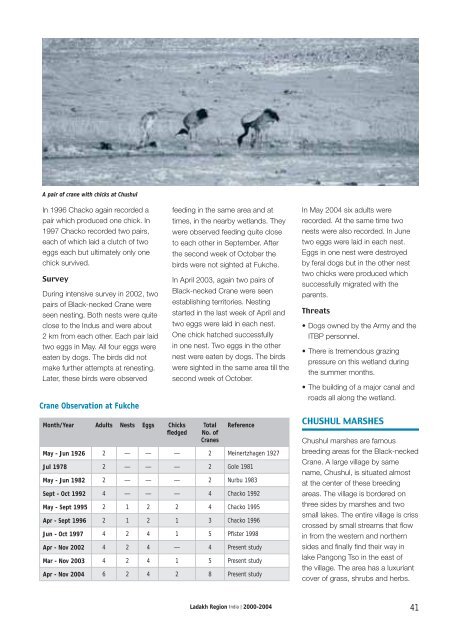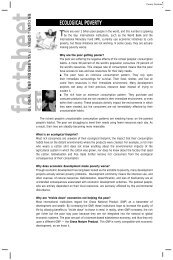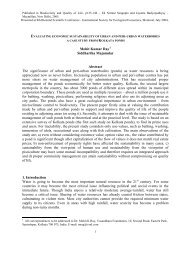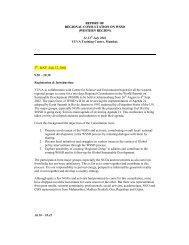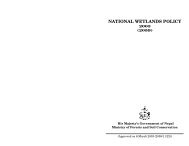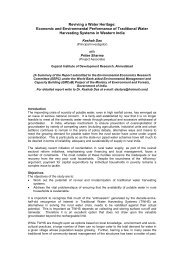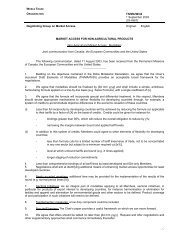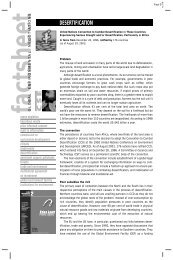Black-necked Crane - WWF-India
Black-necked Crane - WWF-India
Black-necked Crane - WWF-India
Create successful ePaper yourself
Turn your PDF publications into a flip-book with our unique Google optimized e-Paper software.
A pair of crane with chicks at Chushul<br />
In 1996 Chacko again recorded a<br />
pair which produced one chick. In<br />
1997 Chacko recorded two pairs,<br />
each of which laid a clutch of two<br />
eggs each but ultimately only one<br />
chick survived.<br />
Survey<br />
During intensive survey in 2002, two<br />
pairs of <strong>Black</strong>-<strong>necked</strong> <strong>Crane</strong> were<br />
seen nesting. Both nests were quite<br />
close to the Indus and were about<br />
2 km from each other. Each pair laid<br />
two eggs in May. All four eggs were<br />
eaten by dogs. The birds did not<br />
make further attempts at renesting.<br />
Later, these birds were observed<br />
<strong>Crane</strong> Observation at Fukche<br />
feeding in the same area and at<br />
times, in the nearby wetlands. They<br />
were observed feeding quite close<br />
to each other in September. After<br />
the second week of October the<br />
birds were not sighted at Fukche.<br />
In April 2003, again two pairs of<br />
<strong>Black</strong>-<strong>necked</strong> <strong>Crane</strong> were seen<br />
establishing territories. Nesting<br />
started in the last week of April and<br />
two eggs were laid in each nest.<br />
One chick hatched successfully<br />
in one nest. Two eggs in the other<br />
nest were eaten by dogs. The birds<br />
were sighted in the same area till the<br />
second week of October.<br />
In May 2004 six adults were<br />
recorded. At the same time two<br />
nests were also recorded. In June<br />
two eggs were laid in each nest.<br />
Eggs in one nest were destroyed<br />
by feral dogs but in the other nest<br />
two chicks were produced which<br />
successfully migrated with the<br />
parents.<br />
Threats<br />
• Dogs owned by the Army and the<br />
ITBP personnel.<br />
• There is tremendous grazing<br />
pressure on this wetland during<br />
the summer months.<br />
• The building of a major canal and<br />
roads all along the wetland.<br />
Month/Year Adults Nests Eggs Chicks<br />
fledged<br />
Total<br />
No. of<br />
<strong>Crane</strong>s<br />
Reference<br />
May - Jun 1926 2 — — — 2 Meinertzhagen 1927<br />
Jul 1978 2 — — — 2 Gole 1981<br />
May - Jun 1982 2 — — — 2 Nurbu 1983<br />
Sept - Oct 1992 4 — — — 4 Chacko 1992<br />
May - Sept 1995 2 1 2 2 4 Chacko 1995<br />
Apr - Sept 1996 2 1 2 1 3 Chacko 1996<br />
Jun - Oct 1997 4 2 4 1 5 Pfister 1998<br />
Apr - Nov 2002 4 2 4 — 4 Present study<br />
Mar - Nov 2003 4 2 4 1 5 Present study<br />
Apr - Nov 2004 6 2 4 2 8 Present study<br />
CHUSHUL MARSHES<br />
Chushul marshes are famous<br />
breeding areas for the <strong>Black</strong>-<strong>necked</strong><br />
<strong>Crane</strong>. A large village by same<br />
name, Chushul, is situated almost<br />
at the center of these breeding<br />
areas. The village is bordered on<br />
three sides by marshes and two<br />
small lakes. The entire village is criss<br />
crossed by small streams that fl ow<br />
in from the western and northern<br />
sides and fi nally fi nd their way in<br />
lake Pangong Tso in the east of<br />
the village. The area has a luxuriant<br />
cover of grass, shrubs and herbs.<br />
Ladakh Region <strong>India</strong> | 2000-2004 41


